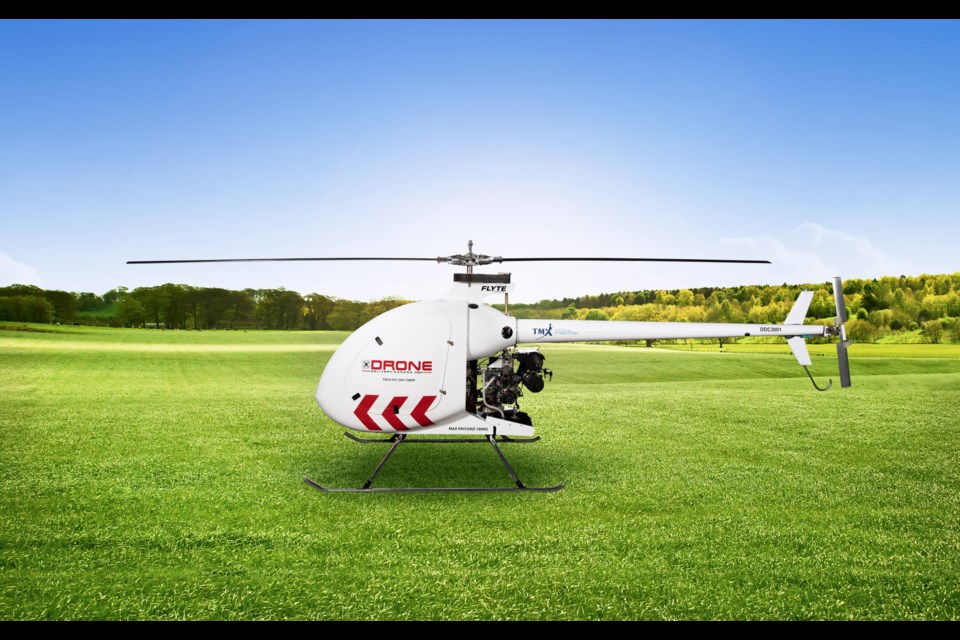Drone Delivery Canada (DDC) says it could take as little as two weeks for the company to roll out a basic drone-delivery system to transport blood tests, deliver blood samples, or haul medical supplies as the COVID-19 pandemic continues.
With concern growing about the spread of the novel coronavirus, an automated, unmanned drone-delivery system has the capability to get supplies to the right people fast, said Michael Zahra, president and CEO of the Vaughan-based logistics company.
He’s encouraging anyone with interest – communities, hospitals, pharmacies, health-care centres – to contact the company directly to start working on building a case for government support.
Although the logistics of each scenario differ, even the simplest setup can be established quickly.
“As an example, we have minimal infrastructure at the point of origin. We have no infrastructure at the point of destination. We have a drone which, unmanned, would take off, would go to the point of origin...goes to a low altitude, drops the cargo, and it comes back,” Zahra said.
“So, that kind of scenario we can implement in a few weeks.”
DDC doesn't yet have any partnership agreements in place, but Zahra said the company has been receiving interest from potential clients, and will work with the provincial and federal governments to help fasttrack funding for approved projects.
Want to read more stories about business in the North? Subscribe to our newsletter.
DDC’s Sparrow drone can carry up to 10 pounds (4.5 kilograms) of payload at a time and is capable of flying 30 kilometres – 15 kilometres each way – before the battery needs changing.
It can fly at night and in inclement weather, operating continuously over a 24-hour period.
The company’s other models include the Robin, which can carry a payload of 25 pounds (11.5 kilograms) and fly 35 kilometres, and the Condor, which can handle 400 pounds (180 kilograms) of cargo and travel up to 200 kilometres.
DDC has had in place a Special Flight Operations Certificate from Transport Canada since early 2018. It gives the company permission to operate across Canada, and exempts the company from filing flight plan routes for each trip.
Typically, the case for drone delivery is strongest for clients that would derive a social or economic benefit from the service, Zahra noted.
Indigenous fly-in communities can receive mail, food, medical supplies, or other packages by drone faster and more cheaply than by air, while mining companies can send tools or drill core samples through the larger models.
Now, as the novel coronavirus spreads and people are being encouraged to practise social distancing and self-isolation, unmanned drone delivery can help people maintain a safe distance while still allowing them to send and receive goods, Zahra noted.
“If you want to limit person-to-person contact, I can take something from a hospital to a nursing home, or hospital to a hospital, or the hospital to a medical lab, and now you don’t have to have that person-to-person contact,” he said.
“So you can do the social distancing through our system, which is completely unmanned.”
The only human contact involved in the process is at the point of origin, with the person loading cargo into the drone before takeoff. But Zahra said DDC has protocols in place – including training and providing appropriate personal protective equipment – to address any concerns.
Remote and isolated First Nations that are only accessible by air could likely benefit the most from the technology, Zahra noted.
In 2003, during the outbreak of severe acute respiratory syndrome (SARS), Indigenous communities were disproportionately impacted, he noted, mostly because of poor health-care infrastructure in those communities and underlying health conditions experienced by many of the residents.
Employing drones now could be an opportunity to avoid a repeat of that scenario, Zahra said.
“If I’m taking blood tests from a remote First Nations community, as an example, and I need to get that blood temperature-controlled and in a timely fashion to a lab to do a COVID-19 test, if I can get it there in 10 minutes instead of four days by truck, or whenever the next airplane is available next week, that makes a difference.”
Around the globe, drones are already being used in various applications to help monitor and detect the spread of the virus.
In Australia, the company Draganfly is working with the University of Australia and the Australia Defence Department to equip drones with sensing technology to detect when people show signs of infection, while in China drones have been used for everything from spraying to sanitize an area to delivering groceries.
Zahra believes DDC can offer Canada its own solution for addressing the COVID-19 crisis, and now is the time to act.
“We’re fully commercialized and operational,” Zahra said. “We’re ready to implement now.”
Contact DDC directly at covid19@dronedeliverycanada.com for more information.




